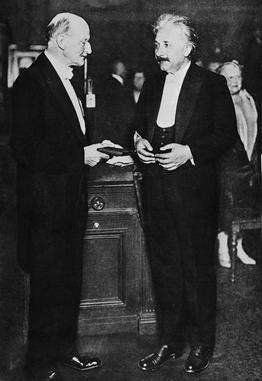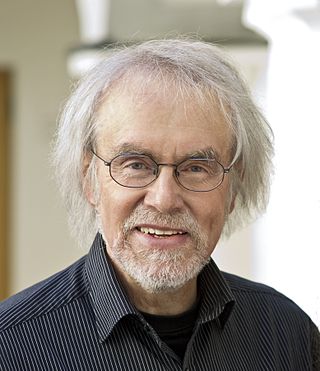
The Max Planck medal is the highest award of the German Physical Society (Deutsche Physikalische Gesellschaft), the world's largest organization of physicists, for extraordinary achievements in theoretical physics. The prize has been awarded annually since 1929, with few exceptions, and usually to a single person. The winner is awarded with a gold medal and hand-written parchment.

The German Physical Society is the oldest organisation of physicists. The DPG's worldwide membership is cited as 52,220, as of 2022, making it one of the largest national physics societies in the world. The number of the DPG's members peaked in 2014, when it reached 63,000, but it has been decreasing since then. It holds an annual conference and multiple spring conferences, which are held at various locations and along topical subjects of given sections of the DPG. The DPG serves the fields of pure and applied physics. Main aims are to bring its members and all physicists living in Germany closer together, represent their entirety outwards as well as foster the exchange of ideas between its members and foreign colleagues. The DPG binds itself and its members to advocate for freedom, tolerance, veracity and dignity in science and to be aware about the fact that the people working in science are responsible to a particularly high extent for the configuration of the overall human activity.

Rainer Blatt is a German-Austrian experimental physicist. His research centres on the areas of quantum optics and quantum information. He and his team performed one of the first experiments to teleport atoms, the other was done at NIST in Boulder Colorado. The reports of both groups appeared back-to-back in Nature.

Peter Zoller is a theoretical physicist from Austria. He is professor at the University of Innsbruck and works on quantum optics and quantum information and is best known for his pioneering research on quantum computing and quantum communication and for bridging quantum optics and solid state physics.
John Michael David Coey, known as Michael Coey, is a Belfast-born experimental physicist working in the fields of magnetism and spintronics.
The Stern–Gerlach Medal is the most prestigious prize for experimental physicists awarded by the German Physical Society. It is named after the scientists of the Stern–Gerlach experiment, Otto Stern and Walther Gerlach. It was originally called the Stern-Gerlach Prize, and has been awarded annually since 1988. It was converted into a medal in 1992.
The Karl-Scheel-Preis is an award given annually by the Physikalische Gesellschaft zu Berlin, a regional association of the Deutsche Physikalische Gesellschaft, for outstanding scientific work. The prize was established through an endowment by the German physicist Karl Scheel and his wife Melida. Recipients are awarded with the Karl-Scheel Medal and 5.000 Euros. The Karl-Scheel Medal in bronze was designed by the German sculptor Richard Scheibe and has a diameter of 12 cm.
Klaus Blaum is a German physicist and director at the Max Planck Institute for Nuclear Physics in Heidelberg, Germany.
Otto Kratky was an Austrian physicist. He is best known for his contribution to the small-angle X-ray scattering method, for the Kratky plot, and for the invention of the density metering using the oscillating u-tube principle. The worm-like chain model in polymer physics, introduced with Günther Porod in a 1949 paper, is also named the Kratky–Porod model.

Harald Rose is a German physicist.
Annette Zippelius is a German physicist at the University of Göttingen. In 1998 she became a Gottfried Wilhelm Leibniz Prize winner. Her research focuses on complex fluids and soft matter – materials that are intermediate between conventional liquids and solids. Examples are glasses, polymeric melts or solutions, gels and foams, but also granular matter. With her research group she aims at elucidating the underlying principles of self-organization that govern their behavior.
Claudia Felser is a German solid state chemist and materials scientist. She is currently a director of the Max Planck Institute for Chemical Physics of Solids. Felser was elected as a member into the National Academy of Engineering in 2020 for the prediction and discovery of engineered quantum materials ranging from Heusler compounds to topological insulators.

Andrzej Jerzy Buras is a Polish-born Danish theoretical physicist, professor emeritus at the Technical University Munich (TUM).

Dieter Meschede is a German physicist and lightweight rower.
John Antoniadis also known as Ioannis Antoniadis is a Greek astrophysicist. He is mostly known for his research of radio pulsars, a type of rapidly rotating neutron stars.
Andrea Cavalleri is an Italian physicist who specializes in optical science and in condensed matter physics. He is the founding director of the Max Planck Institute for the Structure and Dynamics of Matter in Hamburg, Germany and a professor of Physics at the University of Oxford. He was awarded the 2018 Frank Isakson Prize for his pioneering work on ultrafast optical spectroscopy applied to condensed matter systems.
Nathalie Picqué is a French physicist working at the Max Planck Institute of Quantum Optics in the field Frequency Combs, where she studies ultra-high resolution spectroscopy using ultrashort pulses of light combined with Fourier-transform spectroscopy to reveal the fine chemistry of samples, in particular in the mid-infrared, demonstrating resolving power in excess of 1,000,000,000,000.
Ángel Rubio is a Spanish theoretical physicist and director at the Max Planck Institute for the Structure and Dynamics of Matter in Hamburg. Rubio is also a Distinguished Research Scientist in computational quantum physics at the Simons Foundation's Flatiron Institute in New York City. He is a member of the National Academy of Sciences and a fellow of the American Physical Society.
Astrid Lambrecht is a German physicist who is Director at Forschungszentrum Jülich. She previously worked as the Deputy Director of the French National Centre for Scientific Research Institute of Physics.
Reinhard Stock is a German experimental physicist, specializing in heavy-ion physics.







